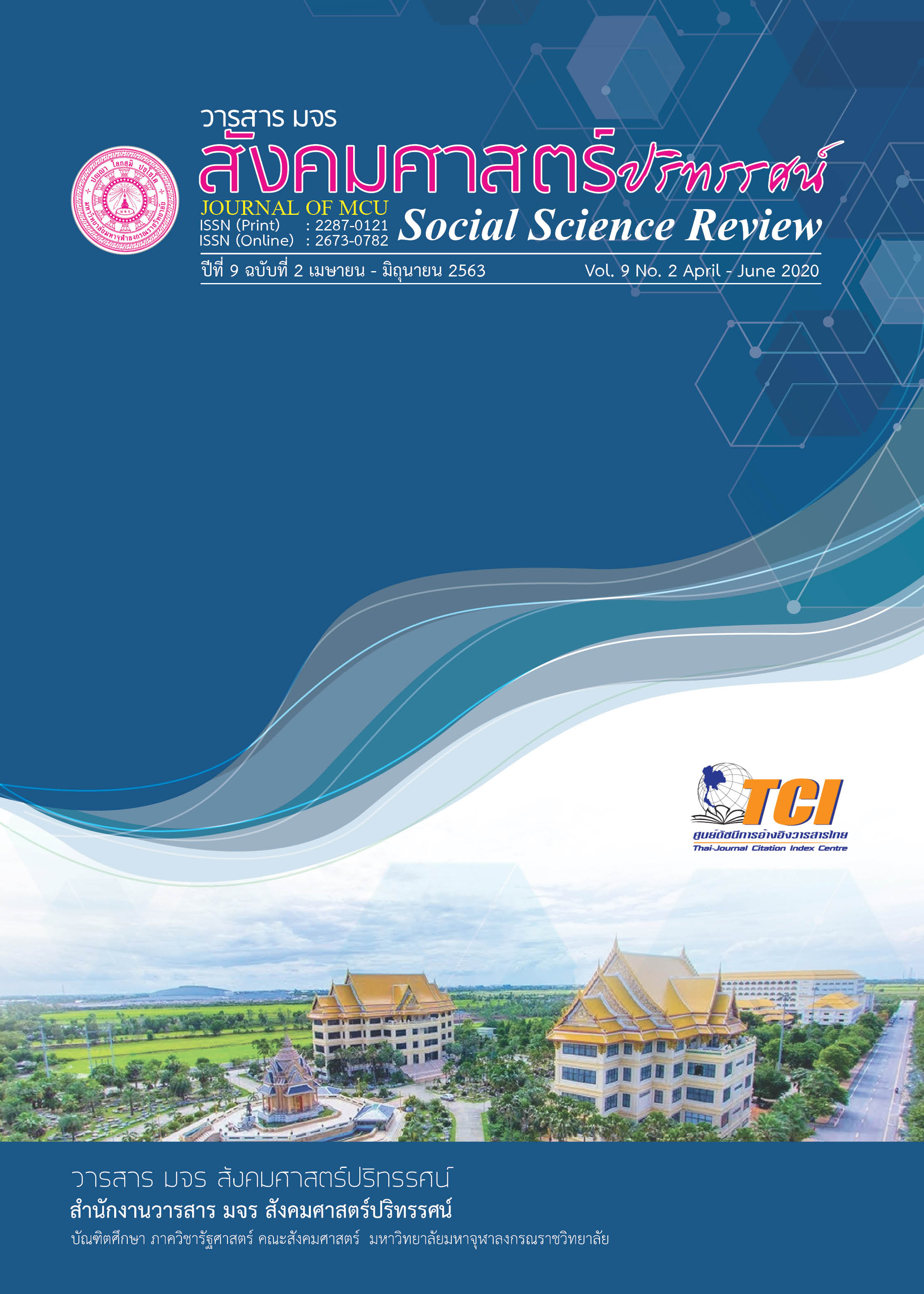รูปแบบการพัฒนาศาสนทายาทของคณะสงฆ์จังหวัดสุพรรณบุรี
คำสำคัญ:
การพัฒนา, ศาสนทายาท, คณะสงฆ์บทคัดย่อ
บทความวิจัยครั้งนี้มีวัตถุประสงค์เพื่อศึกษาสภาพทั่วไป กระบวนการ และนำเสนอรูปแบบการพัฒนาศาสนทายาทของคณะสงฆ์จังหวัดสุพรรณบุรี ระเบียบวิธีวิจัยเป็นแบบผสานวิธี ผลการวิจัยพบว่า 1. สภาพทั่วไปของการพัฒนาศาสนทายาทของคณะสงฆ์จังหวัดสุพรรณบุรี โดยรวมอยู่ในระดับมาก 2. กระบวนการพัฒนา ด้านกาย มีการส่งเสริมให้มีร่างกายแข็งแรงละชั่วทำดี ด้านศีล ส่งเสริมให้มีระเบียบวินัย ตามจารีตประเพณี รักสงบ โดยใช้ศีลเป็นฐาน ด้านจิต ฝึกสมาธิ ให้จิตใจใฝ่กุศล ด้านปัญญา เรียนรู้หลักธรรม พัฒนาความสามารถในการแก้ไขปัญหา 3. รูปแบบการพัฒนาศาสนทายาทของคณะสงฆ์จังหวัดสุพรรณบุรี ประกอบด้วย ด้านการพัฒนากาย ฝึกอบรมให้ความรู้และส่งเสริมในการทำความดี พัฒนาร่างกายให้สมบูรณ์แข็งแรง ด้านการพัฒนาศีล พัฒนาให้ยึดมั่นดำรงตนอยู่ในศีลธรรม มีระเบียบวินัยทางสังคม ไม่เกี่ยวข้องกับอบายมุข ด้านการพัฒนาจิต ฝึกอบรมให้มีจิตใจสงบ การสอนให้มีความรู้เกี่ยวกับการพัฒนาจิตใจ การพัฒนาจิตใจให้มีจิตใจใฝ่กุศล ด้านการพัฒนาปัญญา สอนให้รู้และเข้าใจหลักธรรม ให้เกิดปัญญา การพัฒนาทักษะในการแก้ไขปัญหา
เอกสารอ้างอิง
กฤษฎา แซ่หลี. (2562). รูปแบบการปลูกฝังคุณธรรมและจริยธรรมสำหรับวัยรุ่นไทยยุคใหม่ ตามหลักพุทธธรรม ผ่านกลไกการขับเคลื่อนโครงการคลินิกคุณธรรม ของพระธรรมวิทยากร. วารสาร มจร สังคมศาสตร์ปริทรรศน์, 8(1), 59-70.
คณะสงฆ์จังหวัดสุพรรณบุรี. (2563). แผนยุทธศาสตร์การปฏิรูปกิจการพระพุทธศาสนาจังหวัดสุพรรณบุรี (พ.ศ. 2561 – 2564). สืบค้น 14 มกราคม 2563, จาก http://www.buddhism4.com/web/fileyuttasart/14suphanburee.pdf
จักรวาล สุขไมตรี. (2557). รูปแบบการพัฒนาทรัพยากรมนุษย์ตามแนวพุทธจริยธรรมระดับอุดมศึกษา (ดุษฎีนิพนธ์ปริญญาพุทธศาสตรดุษฎีบัณฑิต สาขาวิชารัฐประศาสนศาสตร์). พระนครศรีอยุธยา: มหาวิทยาลัยมหาจุฬาลงกรณราชวิทยาลัย.
ฉันทนา จันทร์บรรจง. (2542). การศึกษากับการส่งเสริมคุณธรรม. กรุงเทพฯ: สำนักงานคณะกรรมการการศึกษาแห่งชาติ.
ณัฐชนันตร์ อยู่สีมารักษ์. (2557). รูปแบบการพัฒนาทรัพยากรมนุษย์ตามหลักพุทธธรรมของสถานศึกษาของรัฐ สังกัดกรุงเทพมหานคร (ดุษฎีนิพนธ์ปริญญาพุทธศาสตรดุษฎีบัณฑิต สาขาวิชารัฐประศาสนศาสตร์). พระนครศรีอยุธยา: มหาวิทยาลัยมหาจุฬาลงกรณราชวิทยาลัย.
ธีรศักดิ์ บึงมุม. (2558). การพัฒนาจริยธรรมนักเรียนโดยอาศัยกระบวนการบรรพชาสามเณรภาคฤดูร้อน ศูนย์พัฒนาคุณภาพชีวิตชุมชน อำเภอน้ำพง จังหวัดขอนแก่น. วารสารธรรมทรรศน์, 15(1), 148.
บัญชายุทธ นาคมุจลินท์. (2557). แนวทางการพัฒนาศาสนทายาทที่พึงประสงค์ในพระพุทธศาสนา. วารสารบัณฑิตศึกษา มนุษยศาสตร์ สังคมศาสตร์, 3(1), 140.
ปาริชาติ ธีระวิทย์. (2561). การเสริมสร้างคุณธรรมจริยธรรมสำหรับนักศึกษาระดับอุดมศึกษาในศตวรรษที่ 21. วารสารเทคโนโลยีภาคใต้, 11(1), 37.
พระครูอาทรยติกิจ (ชื้น ปญฺญากาโม). (2563). รูปแบบการพัฒนาศาสนทายาทของคณะสงฆ์จังหวัดสุพรรณบุรี (ดุษฎีนิพนธ์ปริญญาพุทธศาสตรดุษฎีบัณฑิต สาขาวิชาการจัดการเชิงพุทธ). พระนครศรีอยุธยา: มหาวิทยาลัยมหาจุฬาลงกรณราชวิทยาลัย.
พระครูอาทรวชิรกิจ (มานะ ฐานิสฺสโร) และคณะ. (2563). การจัดการหน่วยอบรมประชาชนประจำตำบลในจังหวัดกำแพงเพชร. วารสาร มจร สังคมศาสตร์ปริทรรศน์, 9(1), 148-160.
พระไพศาล พหุสุตฺโต. (2558). วิธีการสร้างศาสนทายาทของพระสายปฏิบัติ ในจังหวัดสกลนคร. วารสารปณิธาน, 11(6), 130.
พระรักษ์พล กุลวฑฺฒโน. (2557). พระกรรมฐานกับการเผยแผ่พระพุทธศาสนาในต่างประเทศ. กรุงเทพฯ: หจก.นารายณ์ อิมเมจแอนด์พริ้นท์.
พระราชวรมุนี (ประยุทธ์ ปยุตฺโต). (2545). ทิศทางการศึกษาของคณะสงฆ์. กรุงเทพฯ : โรงพิมพ์มหาจุฬาลงกรณราชวิทยาลัย.
วิเชียร ชาบุตรบุณฑริก. (2535). พุทธศาสตร์. กรุงเทพฯ : โอ.เอส.พริ้นติ้ง เฮ้าส์.
สำนักงานพระพุทธศาสนาแห่งชาติ. (2561). ข้อมูลพื้นฐานทางพระพุทธศาสนา ปี 2560. สืบค้น 19 มิถุนายน 2561, จาก http://sta.onab.go.th/index.php?option=comcontent&view=article&id=349&Itemid=361
สุริยา รักษาเมือง. (2557). นโยบายและการบริหารจัดการการศึกษาของคณะสงฆ์ไทยในยุคโลกาภิวัตน์. วารสารวิชาการ มหาวิทยาลัยราชภัฏพระนคร, 5(2), 177.
Yamane, T. (1976). Statistics: An Introductory Analysis (2nd ed.). New York: Harper and Row Publications.
ดาวน์โหลด
เผยแพร่แล้ว
รูปแบบการอ้างอิง
ฉบับ
ประเภทบทความ
สัญญาอนุญาต
ลิขสิทธิ์ (c) 2020 วารสาร มจร สังคมศาสตร์ปริทรรศน์

อนุญาตภายใต้เงื่อนไข Creative Commons Attribution-NonCommercial-NoDerivatives 4.0 International License.
เพื่อให้เป็นไปตามกฎหมายลิขสิทธิ์ ผู้นิพนธ์ทุกท่านต้องลงลายมือชื่อในแบบฟอร์มใบมอบลิขสิทธิ์บทความให้แก่วารสารฯ พร้อมกับบทความต้นฉบับที่ได้แก้ไขครั้งสุดท้าย นอกจากนี้ ผู้นิพนธ์ทุกท่านต้องยืนยันว่าบทความต้นฉบับที่ส่งมาตีพิมพ์นั้น ได้ส่งมาตีพิมพ์เฉพาะในวารสาร มจร สังคมศาสตร์ปริทรรศน์ เพียงแห่งเดียวเท่านั้น หากมีการใช้ภาพหรือตารางหรือเนื้อหาอื่นๆ ของผู้นิพนธ์อื่นที่ปรากฏในสิ่งตีพิมพ์อื่นมาแล้ว ผู้นิพนธ์ต้องขออนุญาตเจ้าของลิขสิทธิ์ก่อน พร้อมทั้งแสดงหนังสือที่ได้รับการยินยอมต่อบรรณาธิการ ก่อนที่บทความจะได้รับการตีพิมพ์ หากไม่เป็นไปตามข้อกำหนดเบื้องต้น ทางวารสารจะถอดบทความของท่านออกโดยไม่มีข้อยกเว้นใดๆ ทั้งสิ้น





